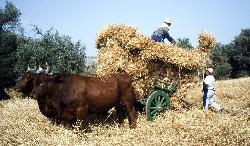Skip navigation bar and go to contents
Vivere la campagna
 Agricoltura
Agricoltura
 Ambiente
Ambiente
 Bilancio e Patrimonio
Bilancio e Patrimonio
 Consigliera di Parità
Consigliera di Parità
 Cultura
Cultura
 Formazione Professionale
Formazione Professionale
 Immigrazione/Emigrazione
Immigrazione/Emigrazione
 Innovazione Tecnologica
Innovazione Tecnologica
 Lavori pubblici e Viabilità
Lavori pubblici e Viabilità
 Lavoro
Lavoro
 Personale
Personale
 Pianificazione Territoriale
Pianificazione Territoriale
 Politiche giovanili
Politiche giovanili
 Politiche Sociali
Politiche Sociali
 Protezione civile
Protezione civile
 Pubblica Istruzione
Pubblica Istruzione
 Sport
Sport
 SUAP
SUAP
 Trasporti
Trasporti
 Turismo
Turismo
 URP
URP

Wheat culture is deeply rooted in this Province. Enhanced by the fertility of its lands, it dates back to most ancient times: the Phoenicians exploited farming resources and it is said that the Romans had made of the island – and of Marmilla, in particular – the breadbasket of Rome.
Since ancient times, then, lots of clues refer to wheat and bread. This latter used to be painted and decorated, as confirmed by plenty of pintadere found in the Nuragic sites of the Province. These are discs worked with incisions of special patterns, aimed at decorating bread by a simple impression technique, before baking.
Ethnographic museums tell us about bread, too, through their ancient tools related to bread-making art. Also, the ancient buildings once hosting old cereal banks are widespread throughout the majority of municipalities in the Province. Finally, the variety of bread itself stands as an evidence of such a deep-rooted tradition.
The itinerary called ‘The wheat routes’ (Le strade del grano) may start right from the fields, to find out ancient farming traditions. Every year, several centres of the Province take them back to life through harvest fairs.
After a trip to the countryside, a visit is suggested to the old centres and local firms, filling the air of the neighbouring streets with a nice smell of freshly-baked bread.
Buildings once assigned to the ancient cereal banks characterize either small and large centres. These structures, duly restored, are currently hosting study centres, museums, bank offices of the ‘Banco di Sardegna’, Tourist Information Centres, exhibition spaces, etc.
Ethnographic and folklore museums are also present (Barumini: Casa Zapata; Lunamatrona: anthropic section of the Museum of the Territory and Demo/ethno-anthropologic Museum; Sanluri: Capuchin Friars’Museum; Siddi: Ethnographic Museum, etc.), offering a diversified choice of traditions associated to bread, including tools used in the past and processing techniques as well.
Not to be missed is the bread fair of Gonnosfanadiga, taking place in autumn. It reserves to visitors a spellbinding blend of flavours, tastes and shapes, completed by genuineness and quality.